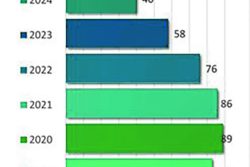A likely preoccupation with managing the incremental socio- economic transformation that is projected to arise out of Guyana’s oil and gas industry should not be allowed to compromise the traditional heavy focus on the country’s agriculture sector, not at a time when concerns over regional and global food security dictate that the country direct more resources towards the continual growth of the sector. An ‘oil economy’ is by no means a substitute for a food-secure country.
This, if the country’s January 16 budget presentation is anything to go by, is one of the overarching messages embodied in the presentation to the National Assembly by Senior Minister in the Office of the President Responsible for Finance, Dr. Ashni Singh.
As Guyana’s now proven vast oil reserves continue to help fashion a template for the country’s long-term socio economic development, Dr. Singh told the National Assembly that the government remains “committed to increasing production and productivity through expansion in acreages and use of technology and diversifying into new crops and varieties, promoting high-value and value-added, including through agro-processing and easing the access for farmers and consumers to market.” All of this Dr. Singh told the National Assembly was being pursued in the interest of “advancing the food security and agri-business agenda” in partnership with the private sector.
This, as Guyana prepares to stage its second international Oil and Gas Conference in less than a month’s time, would appear to be seeking to send a signal that the country is not about to leave its agriculture sector behind at a time when, arguably, food security, for Guyana and for the region as a whole, is no less a priority than is energy security.
In his budget presentation Dr. Singh disclosed that government is aiming to expend G$2 billion on four food security projects that will serve as a barometer for measuring the success of the agriculture sector this year. These are the establishment of a regional security hub, the creation of an enhanced capability to harness greater use of science, technology and research to help promote innovation and product development and the promotion of hinterland agriculture for food security and self-sufficiency and to meet market needs “beyond the local community.”
If the longer term development of the country depends, overwhelmingly, on the contribution made by the oil and gas, sector, it can be argued that, for Guyana, as much as for the rest of the Caribbean, paying attention to food security bona fides is critical to regional socio economic security in the immediate term. While the developments arising out of a potentially lucrative oil and gas sector will be incremental (even if foreign investment and requisites such as job creation and technological growth are likely to move at a fair pace) there is a compelling immediacy associated with the role that the country’s agriculture sector has to play.
Setting aside the role of agriculture in ensuring that Guyana’s food security bona fides maintain a level of stability, the food security fortunes of the rest of the Caribbean may well depend heavily on the contribution that Guyana’s agriculture sector can contribute. If this is to happen the country will have to be the likely ‘lead player’ in two assignments that are both critical and urgent. The first is the establishment of the planned regional food security terminal as a fallback facility in the event of regional food security emergencies; secondly, Guyana will, as well, have to play an important strategic role in helping to steer the process embodied in the recent region-wide decision to reduce regional food imports by twenty five per cent by 2025.
That makes Guyana’s plans for its agriculture sector, this year, are a matter of interest to the entire Caribbean.
The 2023 budget’s preoccupation with food sufficiency suggests that government may not have been indifferent to the dire dire warning issued by the World Food Programme (WFP) Director David Beasley regarding the specter of widespread hunger, going forward, in over eighty (80) countries, unless the existing blockade of Ukrainian grain exports is removed……….”and that is going to be a crisis beyond anything we’ve seen in our lifetime,” he warned.
If, therefore, the eyes of both government and the populace as a whole are likely to be fixed on such incremental developments as might derive from the promised consolidation of the country’s oil and gas sector, the content of the Finance Minister’s budget presentation suggests that the performance of the country’s agriculture sector is no less important on the country’s scale of priorities.
Beyond the size of the state’s investment in the agriculture sector, the Finance Minister outlined some of what he says are government’s priorities for the sector which he says, are shaped have been fashioned “in the interest of advancing the food security and agri-business agenda.” Setting aside the pursuit of the aforementioned regional food hub “incorporating critical elements of the production and supply chain,” the Finance Minister also alluded to government’s pursuit of the establishment of the capacity “to harness greater use of science, technology and research and development to promote innovation and product development” and “promote hinterland agriculture for food security and self-sufficiency as well as to meet the needs of markets beyond the local community.”
The envisaged food security consolidation alluded to in the Finance Minister’s 2023 budget presentation also targets, specifically, rice, corn and soya bean, coconuts, citrus and spices, all crops that are critical cogs in the wider regional food security.
Livestock and agro-processing, too, are also mentioned in Dr. Singh’s budget presentation as areas of the wider agricultural sector that can do much not just to add value to the sector but also to contribute to the local and regional food security priority that obtains at this time.
If there is strong element of ‘feel good’ to Dr. Singh’s presentation on how the 2023 budget will treat with the country’s agricultural sector, however, Guyanese are not likely to be unmindful of the fact that budget presentations, whatever else they may be, are, as well, instruments that are intended to engender positivity, show the best side of government’s intentions. In the instance of the agricultural sector, particularly, all too frequently, actuality tends to fall some distance from promises. This, one feels, is a function of the subject Ministry’s historic preoccupation excessively ‘big-ing the sector, making utterances with respect to development in the various sub-sectors that, all too often, fail to materialize.
It is no secret, for example, that the growth of the country’s agro-processing sector and the promised role of the Guyana Marketing Corporation (GMC) in finding external regional and international markets for agro-produce have not materialized anywhere close to the scale that had been envisaged. While the recent rush of interest in creating agro processing facilities across the country in an effort to give renewed purpose and impetus to farming in the beneficiary communities, the GMC is not known to have ‘delivered’ anywhere near sufficiently in terms of securing local and external markets for agro produce.
To cause agro processing to make the kind of contribution that appears to be envisaged by the Ministry of Agriculture, government will have to find ways of:
• Ensuring the efficient and productive operation of its new agro processing facilities in the various regions;
• Creating workable links between farmers and the agro processing facilities in the regions;
• Developing systems that monitor quality control and product standards for the manufactured products;
• Establishng reliable quality control regimes for products manufactured at the regional agro-processing facilities;
• Ensure the existence of reliable mechanisms for the movement of products from ‘factory’ market;
Whether the Ministry of Agriculture and its ‘satellite’ entity, the Guyana Marketing Corporation, possesses the human resource capacity to deliver on the undertakings reflected in the Finance Minister’s presentation, is unclear. Precedent counsels, however, that the plethora of experiences of budgetary undertakings, (particularly in agricultural sector) that fall flat on their faces, dictates that undertakings, this time around, be tempered by a more generous measure of realism. After all, the portents point unerringly at the critical role that the agriculture/agro processing sector will have to play this year if is to deliver on what, going forward, are its decidedly weighty responsibilities.








